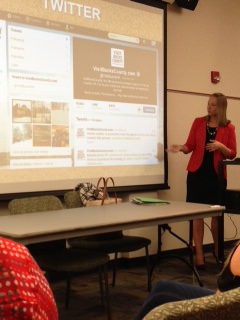
You’ve likely heard the statistic before; in many surveys, people rate the fear of public speaking above the fear of death.
In college, I dreaded my required public speaking class so much that I pushed it off to senior year, until I finally took the course surrounded by a classroom full of freshmen.
In my never-ending quest to get gutsy, I’m turning my fear of public speaking into one of my strong suits; in fact, it’s now one of my favorite things to do!
Since graduating from college in 2010, I’ve made it a goal of mine to seek out public speaking opportunities. I’ve spoken at various colleges including Villanova University, the University of Delaware and my alma mater, Temple University. I’ve been a part of social media panels for the Philadelphia Public Relations Association, as well as for work. And in November, in perhaps my most nerve-wracking public speaking experience to date, I presented at the Social Media and Tourism Symposium, to a room of more than 100 colleagues.
Yes, public speaking can be scary, but it can also be extremely rewarding. Here are five easy ways to overcome the fear of public speaking.
1. Get the audience involved from the beginning. The first few minutes of a presentation are often the scariest; those are the moments you might be the most shaky, short of breath and sweaty-palmed. To combat these feelings and to get comfortable before speaking to a group, I like to use the first five minutes to get to know my audience. If the group is small enough (under 30-40 people) I actually ask each person to quickly go around the room and introduce themselves. This gives me the chance to get comfortable standing in front of the room, breathe for a few minutes while they talk and learn more about the audience to better tailor the presentation. If the group is larger and personal introductions aren’t possible, ask pointed questions (i.e. if it’s a student group: “How many freshmen are in the room? Sophomores?”). Asking these questions and gaging a response still gives the speaker a moment to pause to reflect, allowing them to get oriented and ready for a successful presentation.
2. Encourage the audience to interact and ask questions. Many of the presentations I’ve done have been quite informal. At the beginning of each presentation, I encourage the audience to interrupt me at any time to ask questions. I explain upfront that I want this to be a casual environment and one where audience members can feel comfortable jumping in with questions or comments. Some presenters may not like the audience raising their hand and asking a question in the middle of a presentation because it interrupts their flow, but I personally love it because it means the audience is listening and wants to participate. I’d much rather have my flow interrupted for a moment than speak for 45 minutes straight to a room full of people who are disengaged and maybe even bored.
3. Ask the audience questions. Similarly, I like to put the pressure back on my audience by asking them questions and waiting for an answer during a presentation. In a presentation I did last month to a college class about social media, as I introduced each social network, I asked the students to explain to me how they personally use the site. I was then able to connect their experiences to how social media sites can be used for business. I really enjoy asking questions to my audience because it gives me a moment to pause and breathe, but more importantly, an audience member might bring up a point I hadn’t previously thought of, or bring something else to the table that adds to the quality of the discussion.
4. Use a presentation. This may seem like the most simple tip of all, but I recommend using some kind of presentation software; I prefer PowerPoint, but I’ve heard great things about SlideShare. My PowerPoint slides are usually very simple; they contain a few words and lots of visuals, but having a presentation keeps me focused. Each slide is a cue and reminds me of what logically comes next and keeps my thoughts organized. Plus, the physical act of having a home-base near the podium or computer to click to the next slide is a nice little crutch to again pause and re-orient if I get taken off track or get nervous. Of course, this technique may not be for everyone; I’ve been to many presentations where the presenter speaks freely for an hour and does a great job, but to tame nerves and lessen the stress of the situation, I personally find that leaning on a presentation helps immensely.
5. Demonstrate a skill. In a few recent presentations about social media, after I explain each site, I actually log on to my company’s Facebook or Hootsuite account to show specific examples of posts that worked well or techniques we use on a specific social network. I really love doing these kinds of demonstrations because I find that I’m most comfortable when I’m actively showing the nitty-gritty of how to do something. Additionally, I think the audience appreciates seeing HOW something is done, rather than just learning the WHAT or WHY. Quick tip: if you do demonstrate specific websites in a presentation, be sure to pull the sites up before you get started; this will prevent you from nervously fumbling and typing in the wrong URL.
What about you? How have you overcome the fear of public speaking? Share tips in the comments below.

